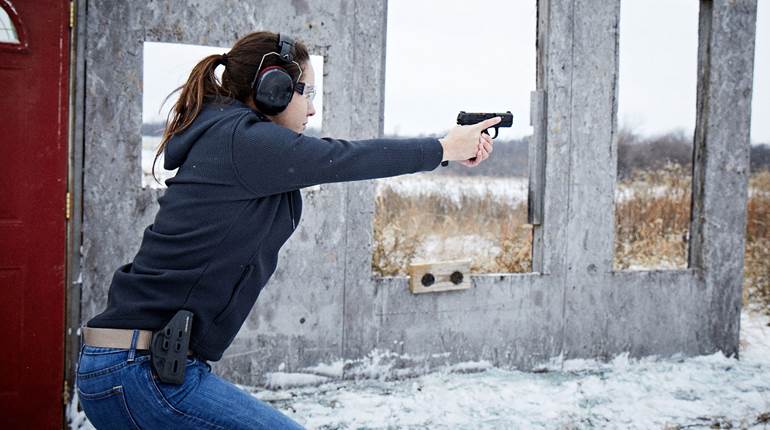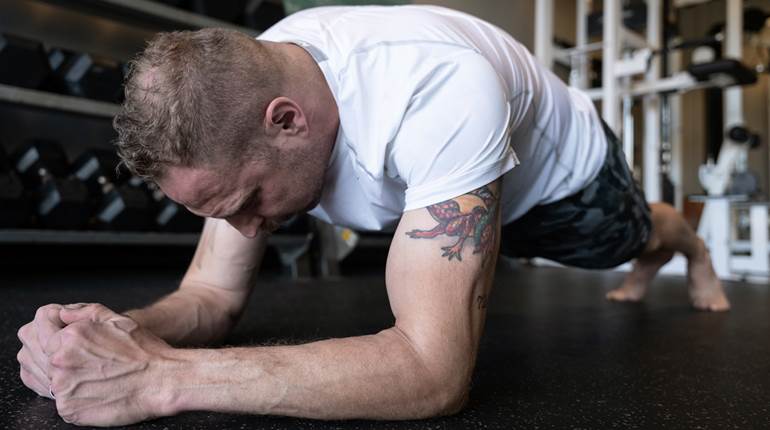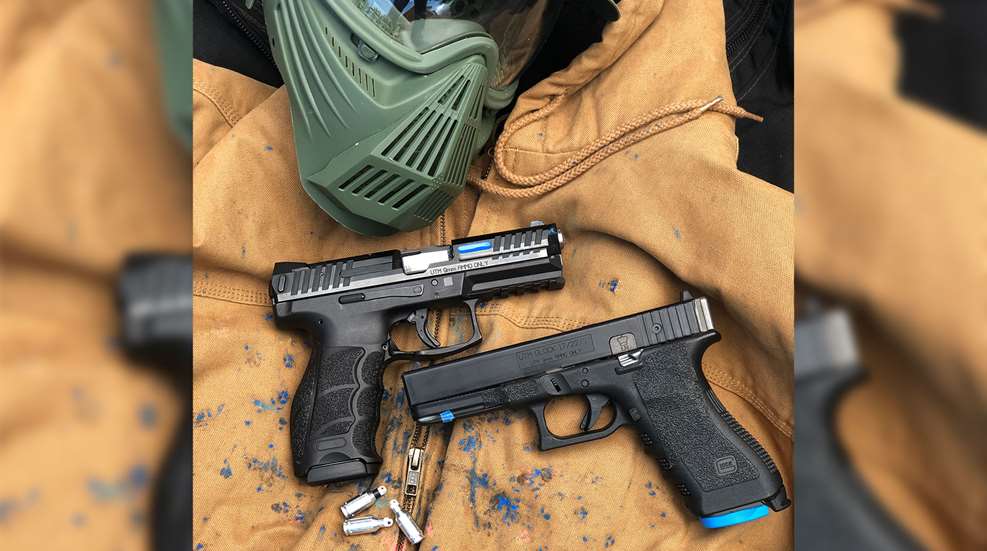
The overwhelming majority of defensive and even military or law-enforcement handgun training is conducted on a standard firing line, against an immobile, two-dimensional paper target representing a threat. Here and there, participants may have access to more advanced target systems, which turn, swing, move or otherwise attempt to simulate a more mobile threat but not terribly often. The best answer in most advanced training is some type of force-on-force scenario.
Force-on-force (FOF) training is where a student uses some type of simulated firearm, launching a non-lethal projectile, to engage real people role playing a threat. However, there are several varieties of this type of training, and each has a different objective and focus. Over the years, I have either participated in or led each type in both the military and open-market settings. Broadly, the types are technical FOF, scenario training, tactics training and integrated combatives training. I’ve seen the terms interspersed and misapplied quite a bit lately, so thought it would be worthwhile to define and describe each.
The Value
FOF training does a number of things really well, which traditional live fire training struggles to accomplish. These include:
- Moves targetry into a rapidly shifting, 360-degree environment. The "target" doesn’t want to get shot; whether with paintballs, Airsoft BBs or marking rounds. Students are often surprised by how quickly the target moves and changes shape as the "threat" attempts to minimize their exposure or moves to employ their own firearm.
- Forces awareness and decision-making into real-time practice. Force-on-force training takes the “Well, I would just...” mental exercise one does when seeing a security or body-camera video of an encounter and tests it against a live role player and scenario. Students are often surprised at how quickly cues must be processed and acted upon.
- Conditions students to work through pain, fear, and opposition. Even simple scenario training without firearms helps students become more assertive and confident. Some student's first exposure to being hit with marking rounds is to "unplug" from whatever they were attempting to do and focus exclusively on the sting of impact. This is a necessary step for some, and the disappointment is needed to stay in the action moving forward. It is common to see students who go from shrieking in pain and turning away from the threat, to staying calmly in control of their marksmanship within just a few runs.
- Validates the student’s training priorities. Most students’ defensive training regimen is dictated by their best guess as to what matters, or it defaults to what they most enjoy. Force-on-force, done well, is as good a test as one can have, short of a real defensive encounter. When I teach technical FOF classes, I poll the class as to what, if any, changes they wish to make to their practice sessions, moving forward. Each student usually has very specific and detailed points of emphasis they wish to incorporate or change after the experience.
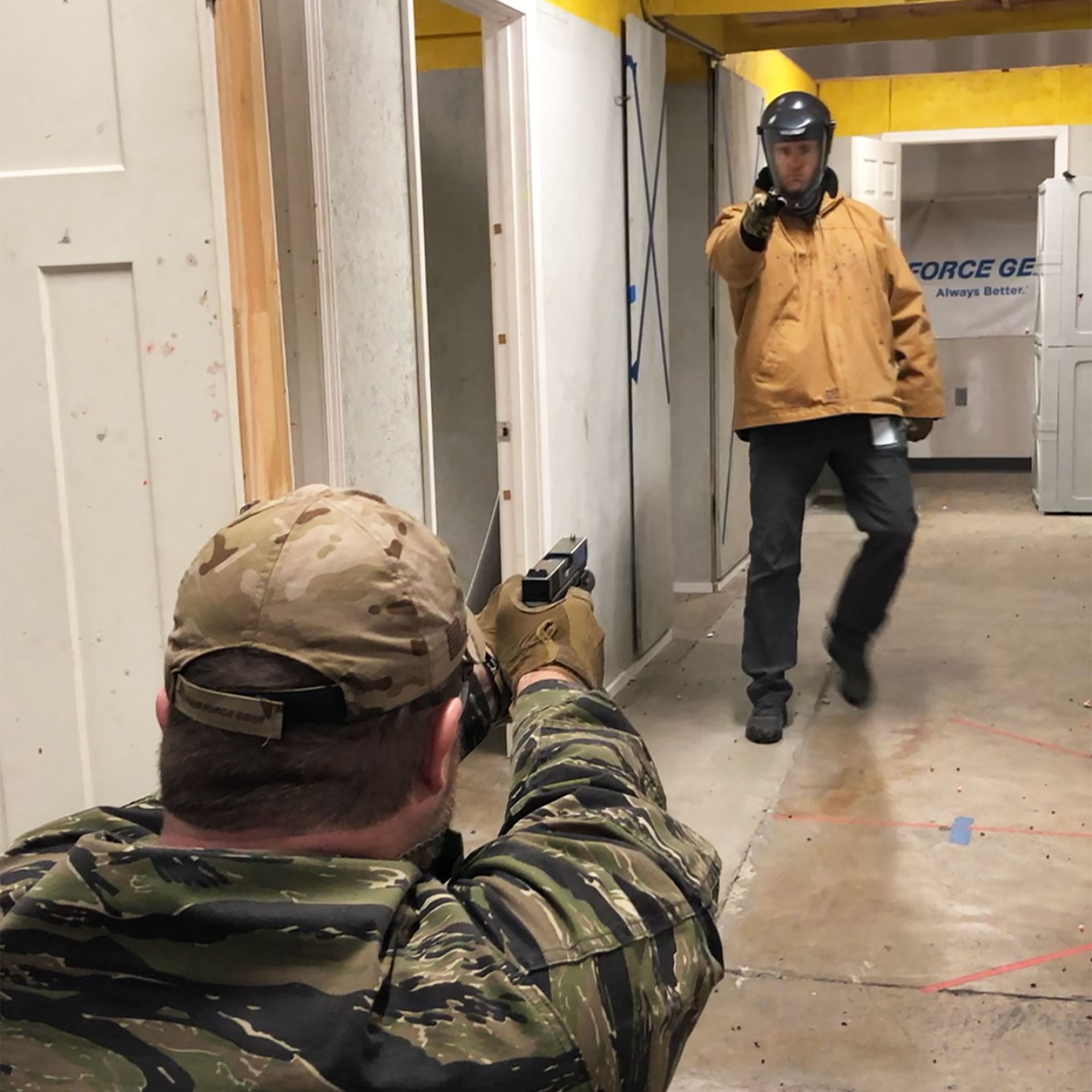 Technical Force-on-force focuses purely on gun-handling and marksmanship against live threat targets with minimal decision-making or scenario emphasis.
Technical Force-on-force focuses purely on gun-handling and marksmanship against live threat targets with minimal decision-making or scenario emphasis.
Technical Force-On-Force
This is where the student is narrowly focused on the application of their handgun or carbine against a live target, who may also be returning fire. It is the "missing link" between traditional range training on defensive pistolcraft and full blown FOF scenarios. In technical Force-on-force, the drills may look quite similar to a traditional live-fire class, such as draw from the holster and fire two shots, except that the student is shooting at a fellow human, instructor or classmate with either airsoft BBs or paint-marking rounds. Technical FOF may build to multi "target" or more complex drills, but the emphasis is primarily on marksmanship and firearm handling in a three-dimensional environment.
Executed properly, technical FOF is tightly scripted and de-emphasizes the decision-making scenario which led to the firearm being the solution. The student is simply asked to execute the tasks within the scenario’s context or against a live opponent who may be doing the same drill. Technical FOF is still predominantly found in specialized military and LE unit training, with limited private trainers offering the training. I suspect this will change in the coming years.
Scenario Training
Also known as use-of-force, escalation-of-force and other names, scenario training emphasizes an ambiguous situation where the student has to interact with the role players and determine what the correct level of force (if any) may be and apply it. In some cases, the emphasis is on the decision-making, more so than the technical aspects of the response. In other venues, the emphasis may be more on the fluid integration of verbal, non-lethal and firearms skills.
Scenario training has been around for a long time but appears to be making inroads and gaining further interest. There are private training facilities, such as West Orlando Firearms Training (W.O.F.T.), which have taken scenario training to a truly immersive experience, tailored to the client’s skills, lifestyle and needs. I’ve attended and conducted scenario training in several Marine Corps, schools, and the great challenge is a scenario that "makes sense" to all involved, along with the ability of the role players to "act" out their assigned roles to allow a scenario to have realness and flexibility. In a recent media event at W.O.F.T., I was thoroughly impressed by the range of scenarios presented. I was also impressed by the staff’s ability to "play" the scenario out realistically and with maximum learning value, inside a coffee shop full of people.
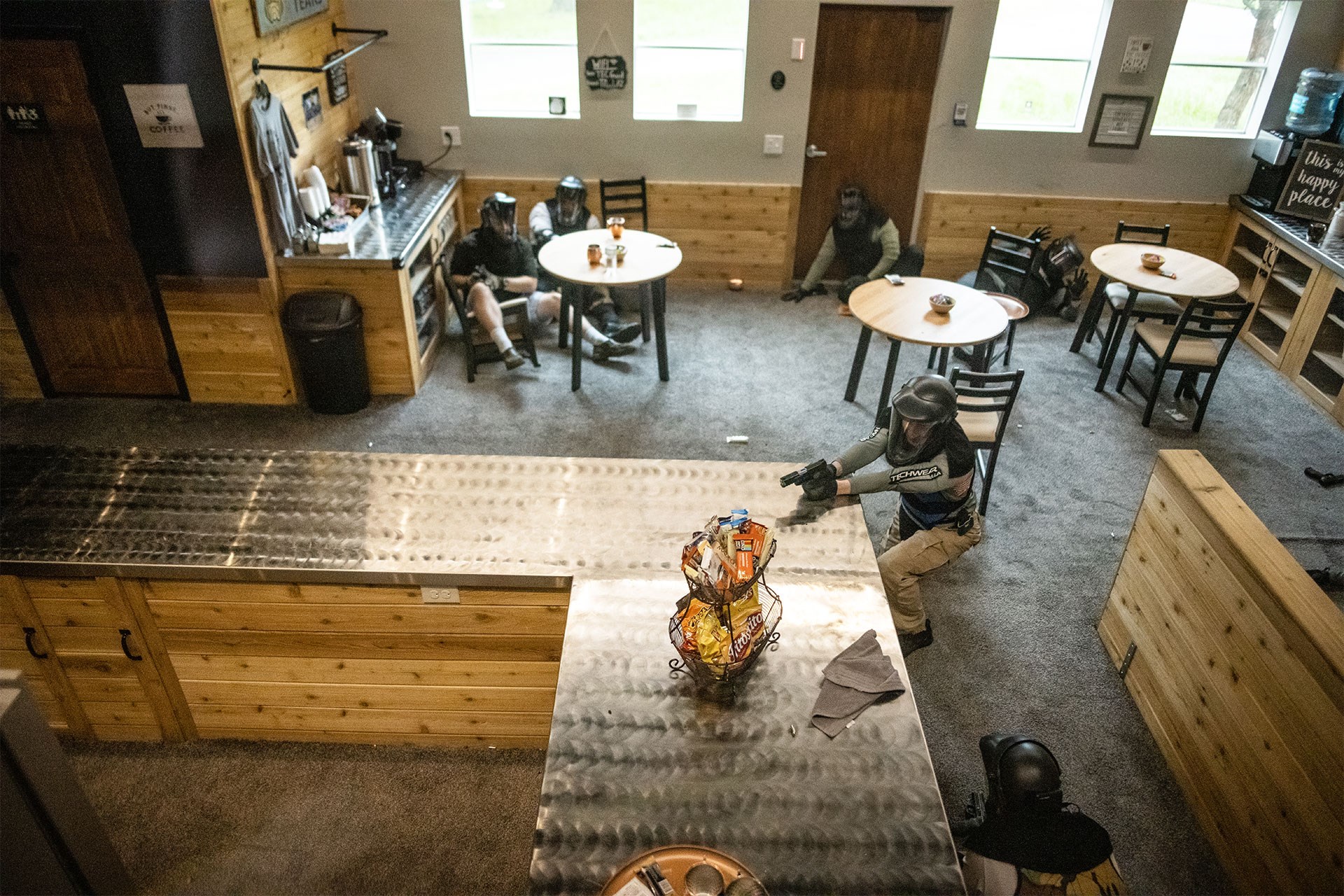 Students working through a lethal encounter in a mock coffee-shop scenario at W.O.F.T.
Students working through a lethal encounter in a mock coffee-shop scenario at W.O.F.T.
This is a type of training where the experience and maturity of the instructor staff and fellow students matters greatly. The most carefully crafted scenario can quickly turn into adult "cops and robbers" without a knowing touch. This is also an area where context and legal implications matter. Great instructors provide a learning environment where the student can practice their awareness, decision-making, deescalation or, if needed, application of force in a relevant context and grounded in an understanding of applicable case law.
Tactics Training
Tactics training using force-on-force tools, such as airsoft or man-marking rounds, is often the team or collective level of the discipline. This is where the lone student or team is applying marksmanship and tactics in a fluid, opposed environment. This includes the armed citizen clearing a simulated residence or the local police department conducting a drill with role players portraying innocent victims as well as threats. The emphasis is often on the use of cover, angles, intra-team communication and the correct application of door, room and hallway procedures. This training has long been the culminating event within special military and SWAT-type groups but has become increasingly popular in the private sector.
Integrated Combatives
This is part of the force-on-force family but has a somewhat different emphasis. Integrated combatives is a multi-disciplinary approach to close-quarters or entangled fighting. To the outside observer, it looks a lot like ground fighting or wrestling with marking pistols and training knives thrown into the mix. For many years, topics were siloed into discreet training subjects, such as hand-to-hand, firearms, defensive tactics, blade work and so on. The combatives approach breaks down the barriers between those topics to have students spar in scenarios that may end with simple takedowns or require the student fighting to retain their pistol while using strikes to create space to employ it.
Craig Douglas’ Extreme Close Quarters Concepts (ECQC) is the gold standard for this type of FOF, and to such a degree that in many professional circles the acronym ECQC is used in place of integrated combatives. I’ve been hearing outstanding reviews of the course for more than a decade and, just this past summer, was finally able to take the class. Craig describes ECQC as "an honest experience," and that is well-said. I was taken down, stabbed, beaten and shot by classmates in challenging scenarios. Each time, vital lessons were driven home.
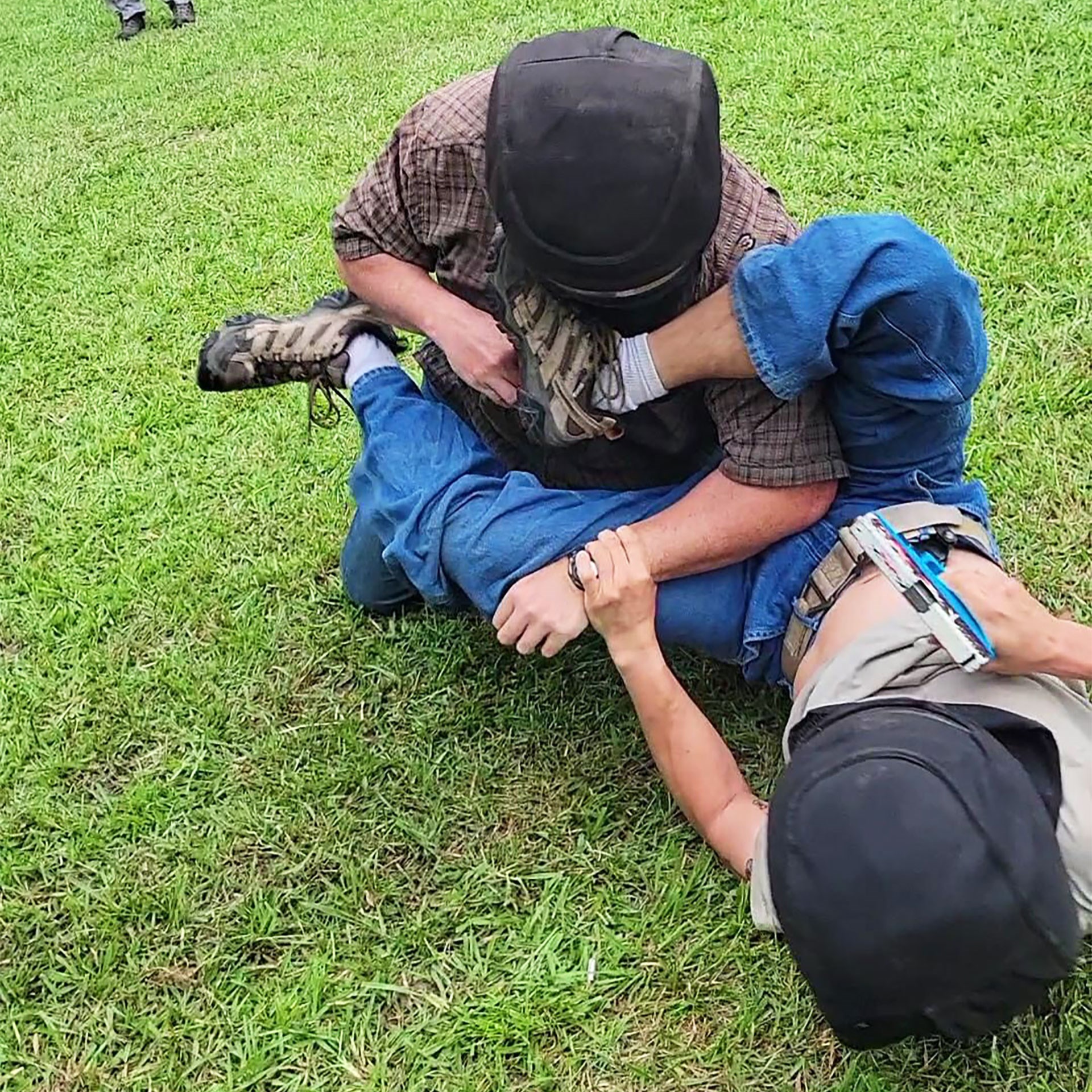 A student has drawn his concealed firearm to defend himself during an attack at a Shivworks ECQC Class. Integrated combatives blends grappling, bladework and entangled shooting.
A student has drawn his concealed firearm to defend himself during an attack at a Shivworks ECQC Class. Integrated combatives blends grappling, bladework and entangled shooting.
The Tools
Gone are the days where cops fired primer-launched paraffin wax through their service revolvers. Most force-on-force training is now conducted with training pistols that cannot chamber and fire a live round. As you can imagine, pointing a firearm at a fellow student and shooting at them carries significant risk. Umarex has its T4E trainers, which use C02 to launch paintballs, or the company's close facsimile Glock airsoft pistols. Both systems look like their respective real-steel counterparts and may fit in some holsters but are not functionally or legally firearms. This has certain advantages in some venues, and both systems are valid tools.
The other approach is to as closely simulate the function of the pistol with a conversion slide and barrel that adapts the live pistol’s frame to launch marking rounds. Simuntion and UTM are the two main systems, each with a proprietary waxy-paint filled plastic cartridge that one loads into the magazine and fires through a sub-caliber barrel. Either system's cartridges works through the student’s actual pistol frame and magazines and also cycles as normally as possible while not allowing actual live ammunition to chamber or fire. When the trainee is struck by either lightweight plastic projectile, the "bullet" mushrooms, leaving a waxy splotch of color to mark the shot placement. In short order, the impact will also leave a welt on the trainee’s skin under the protective clothing layers.
Marking rounds are usually low-noise and low-recoil, so much so that some trainers use them as an introductory step in marksmanship training to familiarize shooters with fundamentals and the pistol’s operations before going to live ammo. The felt recoil on the marking pistols is somewhere between rimfire and typical 9 mm, requiring shooters to apply sound handling techniques. It feels close enough to live ammo to not give an overly false sense of capability in opposed scenarios.
With either airsoft or UTM, the shooter must use some basic personal protective equipment. Marking rounds often break unprotected skin, and the lightweight projectiles may be non-lethal, but they will reliably dent a standard baking sheet with enough force to remove any doubt as to the need for PPE. Face and eye protection is absolutely required, and most students use some type of paintball mask. A hockey neck guard is a good idea as well, to protect the sensitive areas there. Gloves are also a must, as any veteran of force-on-force training will immediately comment on how often the hands get hit.












